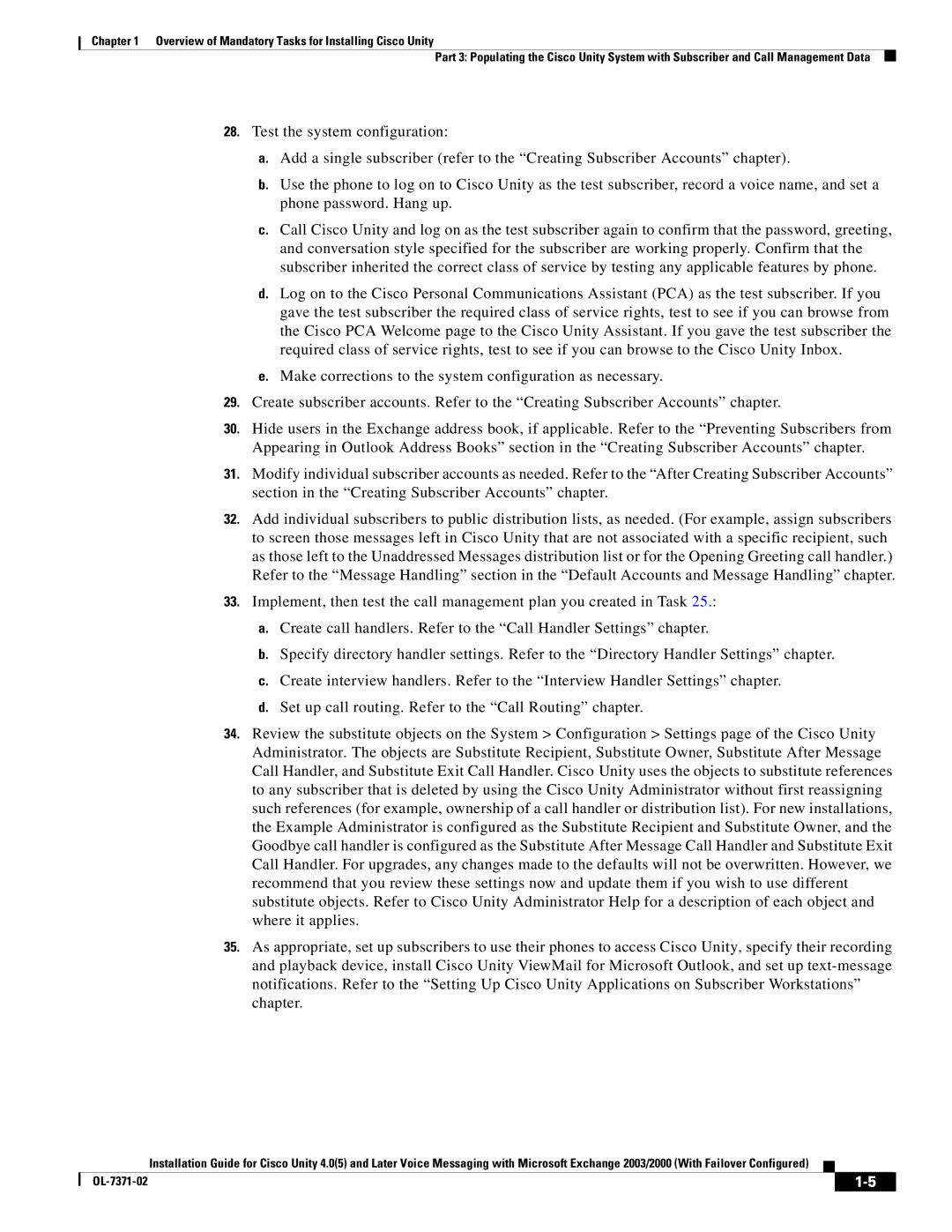
Chapter 1 Overview of Mandatory Tasks for Installing Cisco Unity
Part 3: Populating the Cisco Unity System with Subscriber and Call Management Data
28.Test the system configuration:
a.Add a single subscriber (refer to the “Creating Subscriber Accounts” chapter).
b.Use the phone to log on to Cisco Unity as the test subscriber, record a voice name, and set a phone password. Hang up.
c.Call Cisco Unity and log on as the test subscriber again to confirm that the password, greeting, and conversation style specified for the subscriber are working properly. Confirm that the subscriber inherited the correct class of service by testing any applicable features by phone.
d.Log on to the Cisco Personal Communications Assistant (PCA) as the test subscriber. If you gave the test subscriber the required class of service rights, test to see if you can browse from the Cisco PCA Welcome page to the Cisco Unity Assistant. If you gave the test subscriber the required class of service rights, test to see if you can browse to the Cisco Unity Inbox.
e.Make corrections to the system configuration as necessary.
29.Create subscriber accounts. Refer to the “Creating Subscriber Accounts” chapter.
30.Hide users in the Exchange address book, if applicable. Refer to the “Preventing Subscribers from Appearing in Outlook Address Books” section in the “Creating Subscriber Accounts” chapter.
31.Modify individual subscriber accounts as needed. Refer to the “After Creating Subscriber Accounts” section in the “Creating Subscriber Accounts” chapter.
32.Add individual subscribers to public distribution lists, as needed. (For example, assign subscribers to screen those messages left in Cisco Unity that are not associated with a specific recipient, such as those left to the Unaddressed Messages distribution list or for the Opening Greeting call handler.) Refer to the “Message Handling” section in the “Default Accounts and Message Handling” chapter.
33.Implement, then test the call management plan you created in Task 25.:
a.Create call handlers. Refer to the “Call Handler Settings” chapter.
b.Specify directory handler settings. Refer to the “Directory Handler Settings” chapter.
c.Create interview handlers. Refer to the “Interview Handler Settings” chapter.
d.Set up call routing. Refer to the “Call Routing” chapter.
34.Review the substitute objects on the System > Configuration > Settings page of the Cisco Unity Administrator. The objects are Substitute Recipient, Substitute Owner, Substitute After Message Call Handler, and Substitute Exit Call Handler. Cisco Unity uses the objects to substitute references to any subscriber that is deleted by using the Cisco Unity Administrator without first reassigning such references (for example, ownership of a call handler or distribution list). For new installations, the Example Administrator is configured as the Substitute Recipient and Substitute Owner, and the Goodbye call handler is configured as the Substitute After Message Call Handler and Substitute Exit Call Handler. For upgrades, any changes made to the defaults will not be overwritten. However, we recommend that you review these settings now and update them if you wish to use different substitute objects. Refer to Cisco Unity Administrator Help for a description of each object and where it applies.
35.As appropriate, set up subscribers to use their phones to access Cisco Unity, specify their recording and playback device, install Cisco Unity ViewMail for Microsoft Outlook, and set up
Installation Guide for Cisco Unity 4.0(5) and Later Voice Messaging with Microsoft Exchange 2003/2000 (With Failover Configured)
|
|
| |
|
|
